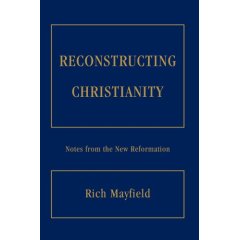Issue 15
March 20, 2007
One of the first things that strike you about the National Cathedral in Washington D.C. is just how impractical it is. The immense gothic structure has terrible sight lines, lousy acoustics and an ambient temperature just above freezing. From where I sat last Friday night (along with three thousand other soon to be peace-marchers) the only way I could see what was going on in the chancel was by watching one of the half-dozen flat screen TVs that hung incongruently from the immense columns that stretched sentinel-like down the nave.
There was, however, and most curiously, something very comforting about such architectural foolishness. Some of it came from knowing that this same ecclesiastical design has been used for centuries to house the hopes of millions.
I remember attending mass at the magnificent cathedral in Chartre, outside of Paris, many years ago and, even though I understood little of what was being said, I felt an enormous connection with the countless pilgrims from the past who once stood where I was then standing. I often curse the burdens of tradition but there are times, many times if the truth be told, when I realize its blessings.
Comfort was drawn, as well, as I tried to focus on a cathedral ceiling that seemed to reach beyond my focal plane. Cavernous structures cannot hope to achieve affirmation in these ecologically sensitive times and yet that vast and admittedly wasted space sent my spirit soaring. The immense emptiness welcomed my imagination, inviting me into a world of wonder. Such architectural excessiveness, I realized again, pits my occasionally prudent, even prissy, piety against the extravagance of grace.
The new cathedrals, mega-churches is how they’re now named, eschew waste by building theatres of comfort with acres of convenient parking. Sanctuaries are replaced with auditoriums whose slanted floors guarantee a good seat to all. Digital sound and graphics provide the needed accoutrements and narthexes are no longer employeded since processions are passé. Certainly there is drama but it comes with the hyperkinetic excess that too often accompanies insipid substance. The audience, it is assumed, leaves contented, pleased with the program.
And the programs are usually very well ordered. We don’t much care for chaos, we Christians. A nice, cohesive plan is what we find motivating…simple answers to profound questions, when questions are even allowed. Christianity, it seems, has forgotten the beginning tenet of its sacred story: Out of chaos comes creation.
The cathedral’s construction was, of course, carefully considered and realized but, given the tenor of these times, it seems a confusing creation. It offers little of what the world of Christianity seems to want these days. Clear answers and definitive doctrine seem less attainable in the magnificent mystery of this strange and foolish space.
And this cathedral, with its obvious lack of concern for congregational comfort, exudes a different, even disturbing, sense of being. Seen from above, the cathedral declares its intention. It is built as a cruciform and this architectural cross proclaims a distinctive understanding of discipleship. It bespeaks of calling rather than comfort.
And yet, there I sat, last Friday night, comforted by that uncomfortable space. It is a paradox, I know. But what, on this strange journey of faith, is not?
Wednesday, March 21, 2007
Subscribe to:
Post Comments (Atom)


1 comment:
couldn't have ended this entry with anything but a question, eh, old man? and what better time than now to add: Peace be with You, Rich.
Post a Comment